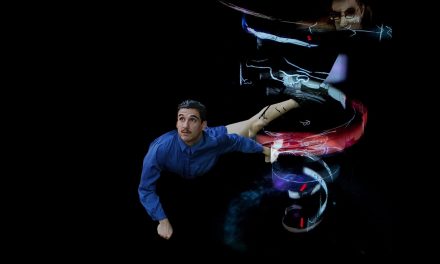Thursday night at REDCAT, Milka Djordjevich’s CORPS brought a train of six women down the house stairs, keeping time in snaps as they walked in unison, monochrome grey uniforms complete with knee pads and pristine white shoes. As it became clear they stood for a sort of laboring class, they called out different movements one at a time, remaining in sync through several iterations of what was essentially a march. The unison cycled through tempos and levels, and a score by Celia Hollander crackled over the speakers, building into an irregular but even warmth.
The corps (Martita Abril, Dorothy Dubrule, Ayano Elson, Allie Hankins, Tiara Jackson and DaEun Jung) cheered, chanted, and kicked in a cycle of somewhat rudimentary movements. They accelerated but never really reached a shared energy, until only one dancer was left onstage, counting her steps and pivots. Then, a new entrance: all the dancers in sparkling gold as designed by Djordjevich, still marching and stepping in time. Lighting by Madeline Best shifted to reflect the costumes’ natural flash in a darker, club-like universe, and the music took a crescendo. The artists began to move with less inhibition, fewer vocal task cues. But not until the final peak and collapse of this escalation did they really begin to move with articulation and attention to the floor.
From a still moment on the ground, each dancer began to vocalize individual phrases (as coached by Odeya Nini, dramaturgy by Tim Reid). They were at their best here, curious and almost languid. They folded, rolled, crawled for almost half an hour as the light waxed and waned off their sequins, each exploring their own universe until they made their way to standing and walking into a final blackout.
I found myself feeling like I missed some context, like the dismantling of a conditioned workforce into an unruly one didn’t quite warrant 90 minutes of postmodern unison. And perhaps I did miss the point – but I think perhaps the thesis could have been stronger, more nuanced, if the movement had latched onto other, more distinct styles for comparison and legibility. Djordjevich could have used or even referenced other languages: there didn’t seem to be enough of a divide between the vocabulary used in the regimented grey uniform act and the pulsing, gold costume act to cement the decline of the corps’ routine.
For such a statement, which felt familiar and even recycled, there was a certain lack of rigor and precision at the start that made the disintegration of unison less effective. The cast was not particularly committed; the performers seemed bored themselves and were most engaging when they misstepped and fell out of line. I wanted more play from Djordjevich in those moments, more investigation of the spontaneous accidents and irregularities.
While the base of the work was intriguing, my short attention span needed more than a single-frequency slow burn. Maybe that’s not Djordjevich’s responsibility – and maybe my own taste for pedestrian movement has dulled independently of this work – but I could not help feeling that this point could have been made in under ten minutes.
To learn more about Milka Djordjevich, please visit her website.
To visit the REDCAT website, please click HERE.
Written by Celine Kiner for LA Dance Chronicle.
Featured image: CORPS by Milka Djordjevich – Photo by Maria Baranova










